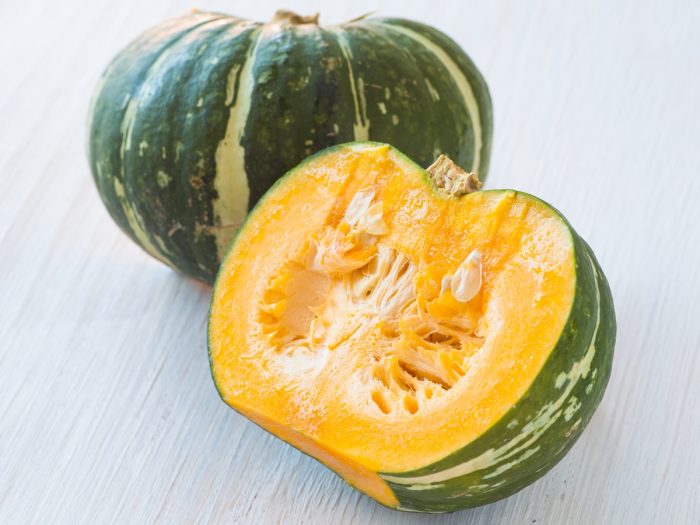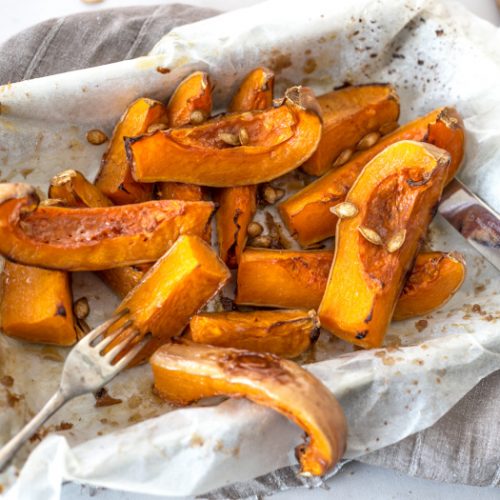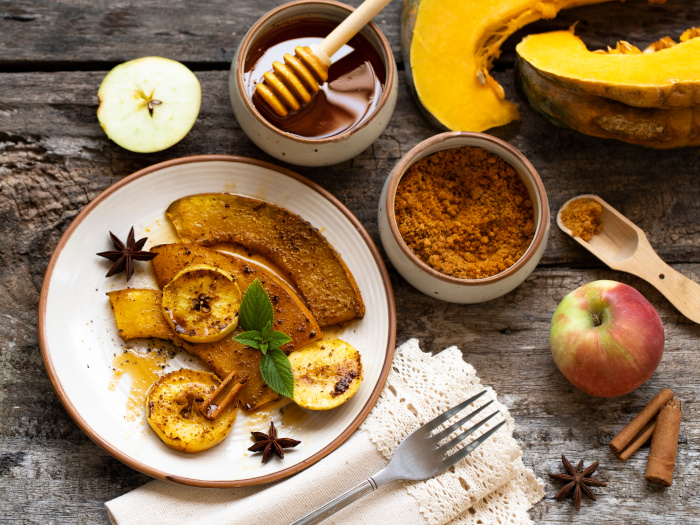If you want to try a new autumnal treat, kabocha squash might be just what you are looking for. Packed with nutrients and able to deliver many health benefits, while also being versatile in the kitchen, this wonderful squash is gaining popularity around the world.
What is Kabocha Squash?
Known as the Japanese pumpkin, kabocha squash is a cultivar of winter squash (Cucurbita maxima). It has a hard exterior and a slightly smaller size than other pumpkins. It is primarily dark green. There may be some light stripes on the rough exterior, and bright orange or yellow flesh inside.
Commonly used in sweet dishes, it is known to have one of the sweetest flavors of any squash. It has an approximate consistency of butternut squash and is quite similar to that variety in many other ways, including how it is cooked. [1]
These fruits are best at the end of the summer or early fall and make an excellent addition to soups and stews, although they can also be cooked as a stand-alone side dish, particularly if seasoned with brown sugar or cinnamon. You will also find kabocha squash as one of the ingredients in vegetable tempura. Aside from the many culinary uses in Japan and beyond, this squash also boasts of impressive nutrients, which offer certain health benefits to those who make it a regular part of their diet.

Kabocha squash is a green Japanese pumpkin that is available all year-round. Photo Credit: Shutterstock
Kabocha Squash Nutrition Facts
Kabocha squash is a rich source of vitamins A and C. It has a low-calorie count, which is only 30 calories per cup. This squash variety is also a good source of iron, copper, magnesium, B vitamins, beta-carotene, dietary fiber, and various antioxidants. [2]
Kabocha Squash Benefits
The most notable health benefits of kabocha squash include its ability to boost skin health, improve vision, strengthen the heart, and aid in weight loss, among others.
Skin Care
Regular consumption of kabocha squash can help your complexion and even reduce the appearance of scars and blemishes. Thanks to the high levels of beta-carotene and other antioxidants found in this variety of squash, it can help reduce oxidative stress in the skin, which can also lower inflammation and prevent signs of aging. [3]
Eye Care
Beta-carotene’s other claim to fame is the impact it can have on vision. The orange color of kabocha squash is largely the result of beta-carotene’s presence in it, which can prevent oxidative stress in the retina, thus reducing your risk of macular degeneration, as well as slowing down the development of cataracts. [4]
Weight Loss
High in dietary fiber and low in calories, kabocha squash makes for an ideal addition to any weight loss diet. Dietary fiber will help keep you feeling full, while the low-calorie count will let you eat as much of this nutrient-dense fruit as you want without compromising your caloric goals. [5]
Improves Heart Health
With a healthy amount of iron, vitamin C, and vitamin A, this squash variety helps retain the integrity of blood vessels and arteries, lowers blood pressure, and ensures healthy circulation.
Aids in Digestion
The dietary fiber in this squash, particularly in the edible rind (after being cooked), can help optimize digestion, regulate bowel movements, and reduce the symptoms of constipation, bloating, and cramping. [6]
How to Cook Kabocha Squash?
The best way to cook kabocha squash is quite similar to how you would cook butternut squash. Depending on what you intend to do with the cooked squash, some of the seasonings may be different. You can follow the steps below to properly cook this exotic squash variety.

Roasted Kabocha Squash With Cinnamon Recipe
Ingredients
- 1 cut into half kabocha squash seeds removed
- 2 tbsp olive oil or coconut oil
- 1/2 tsp pepper
- salt as per taste
- 1 tsp cinnamon powder
Instructions
- Preheat the oven to 400 degrees. Carefully cut the squash evenly in half.
- Scoop out the innards and seeds from both halves of the squash.
- Cut each squash into further halves 3-4 times more to form wedges.
- Rub each wedge with coconut or olive oil and place on a baking sheet covered with a foil.
- Season each wedge with pepper, salt, cinnamon, brown sugar or garlic powder, depending on your taste and preference.
- Bake the squash for 30-35 minutes.
- Allow the squash to cool for 5-10 minutes and then serve or use it in your recipe.

Notes
So, when are you inviting me to the squash party?

